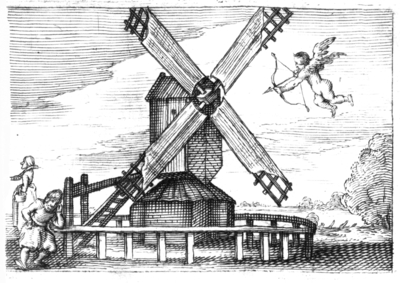Ni spirat immota. [33]

33.
Ni spirat immota.
33.
Ni spirat immota.
Het geen dat my verheugt moet ick van buyten haelen,
Het geen dat my beweegt moet van een ander daelen,
Oft anders ben ick still'. ick moet wel stille staen.
O dat de wint eens quam, soo mocht ick weder gaen.
Dat haeren adem slechs (den oorspronck van mijn leven)
Vuythaeren blijden mondt een windeken wou geven
Op mijn beladen hert, ten minsten van ter sy.
Nu ben ick sonder haer, nu ben ick sonder my.
Het geen dat my verheugt moet ick van buyten haelen,
Het geen dat my beweegt moet van een ander daelen,
Oft anders ben ick still'. ick moet wel stille staen.
O dat de wint eens quam, soo mocht ick weder gaen.
Dat haeren adem slechs (den oorspronck van mijn leven)
Vuythaeren blijden mondt een windeken wou geven
Op mijn beladen hert, ten minsten van ter sy.
Nu ben ick sonder haer, nu ben ick sonder my.
Facsimile Images
Translations
Literature
-
"Windmills occur frequently in Dutch art as visual accents (...), but are surprisingly rare as a primary motif."
(Walford, 57) Walford, Jacob van Ruisdael and the Perception of Landscape

Sources and parallels
-
Parallel in the 1601 edition: motto and subscriptio the same, pictura partly mirrored: Ni spirat, immota [9] (in: Daniël Heinsius, Quaeris quid sit Amor (c. 1601))
[Compare
![Compare [compare]](/static/images/compare2.gif) ]
]
-
Parallel in the 1608 edition: motto and subscriptio the same, pictura partly mirrored. Ni spirat immota [9] (in: Daniël Heinsius, Emblemata amatoria (1607/8))
[Compare
![Compare [compare]](/static/images/compare2.gif) ]
]
-
Windmill and sleeping man: Sambucus, Emblemata
 , embl. 75
, embl. 75
-
Another use of typical Dutch elements within this book:In lubrico. [20] (in: Daniël Heinsius, Ambacht van Cupido, from: Nederduytsche poemata (1616))
[Compare
![Compare [compare]](/static/images/compare2.gif) ]
]
-
Typical Dutch elements also used by Cats in:Dominae, quo me vocat, aura. [29] (in: Jacob Cats, Sinne- en minnebeelden (1627))
[Compare
![Compare [compare]](/static/images/compare2.gif) ]
]
-
Typical Dutch elements also used by Cats in:Dominae, quo me vocat, aura. [28] (in: Jacob Cats, Proteus (1618))
[Compare
![Compare [compare]](/static/images/compare2.gif) ]
]
References, across this site, to this page:
- Dominae, quo me vocat, aura. [28] (in: Jacob Cats, Proteus (1618))
- Dominae, quo me vocat, aura. [29] (in: Jacob Cats, Sinne- en minnebeelden (1627))
- Ni spirat, immota [9] (in: Daniël Heinsius, Quaeris quid sit Amor (c. 1601))
- Ni spirat immota [9] (in: Daniël Heinsius, Emblemata amatoria (1607/8))
- In lubrico. [20] (in: Daniël Heinsius, Ambacht van Cupido, from: Nederduytsche poemata (1616))
Iconclass
A man leaning against the fence that surrounds a motionless windmill; a woman walking along a path behind him; Cupid flying, taking aim- landscapes in the temperate zone
[25H1]

- floating in the air
[31A2763]

- one of the lovers alone (e.g. longing for the beloved)
[33C216]

- awakening love
[33C218]

- windmill
[47D31]

- Rest, Immobility, Stasis (+ situation or event (especially in genre-painting) with symbolical connotation)
[51LL1(+6)]

- (personifications and symbolic representations of) Love; 'Amore (secondo Seneca)' (Ripa) (+ emblematical representation of
concept)
[56F2(+4)]

- Vitality, Viability, Vital Force (+ emblematical representation of concept)
[58B1(+4)]

- proverbs, sayings, etc. (with TEXT)
[86(NI SPIRAT IMMOTA)]

- Cupid shooting a dart
[92D1521]

![[H O M E : Emblem Project Utrecht]](/static/images/rd-small.gif)






















































